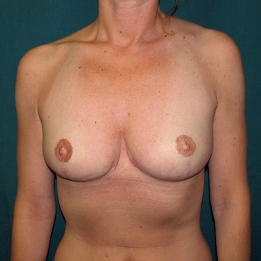Breast Reduction
 Large, heavy breasts can be a source of great discomfort for women of all ages. Breast reduction surgery is the solution to decrease the size and weight of the breasts to create a more proportional and attractive breast shape. Dr. Wesley Schooler, our Ventura-area plastic surgeon, performs breast reduction at our practice in Santa Barbara and serves patients throughout California and nearby states. Combining technical skills and an artistic touch, Dr. Schooler can create a more manageable breast size that enhances your self-confidence and allows you to live life more comfortably.
Large, heavy breasts can be a source of great discomfort for women of all ages. Breast reduction surgery is the solution to decrease the size and weight of the breasts to create a more proportional and attractive breast shape. Dr. Wesley Schooler, our Ventura-area plastic surgeon, performs breast reduction at our practice in Santa Barbara and serves patients throughout California and nearby states. Combining technical skills and an artistic touch, Dr. Schooler can create a more manageable breast size that enhances your self-confidence and allows you to live life more comfortably.
I love my results and wish I’d done it ten years ago!
- What is Breast Reduction?
- Breast Reduction Benefits
- Breast Reduction Candidates
- Breast Reduction vs. Breast Lift
- Breast Reduction Procedure
- Breast Reduction Recovery
- Breast Reduction Results
- Breast Reduction Scars
- Breast Reduction Cost
- Breast Reduction Safety
- Male Breast Reduction
- Breast Reduction FAQ
What is Breast Reduction?
Breast reduction is a cosmetic procedure performed to provide a lighter, more comfortable bust size by reshaping the breasts. During surgery, excess skin, fat, and glandular tissue are removed to decrease the weight of heavy breasts, as well as to achieve a tighter and more youthful breast shape. This also tends to give the breasts a “lift” to some extent. While breast reduction alone will not mimic the exact results of mastopexy, the breasts typically look more perky and rejuvenated following the procedure.
Large breasts can not only make the breasts look disproportionate, but they may also cause physical and emotional discomfort. In general, patients often undergo breast reduction when they experience symptoms like shoulder and back pain, shoulder grooving, chafing, or difficulty exercising as a result of their excessive breast size. Alternatively, many women simply seek out the procedure because they want a more manageable breast size. Whatever your motivations may be, Dr. Wesley Schooler is committed to ensuring you have a strong understanding of the breast reduction procedure.
Why Do Patients Choose Breast Reduction?
Breast reduction is considered among the most rewarding cosmetic surgeries available. Many women pursue breast reduction for aesthetic purposes, such as to attain more rejuvenated and proportionate breasts, while others undergo the procedure to alleviate the burdens of a dominating breast size. In most cases, patients choose breast reduction for a combination of both reasons. Thanks to breast reduction’s ability to eliminate excess breast tissue, skin, and fat, many patients also find it easier to exercise and enjoy physical activities. This, in turn, can allow breast reduction patients to live healthier and more active lifestyles.
Who is a Candidate for Breast Reduction?
Breast reduction can be performed on women of any age who are experiencing the pain and discomfort of heavy, pendulous breasts. In addition to appearing disproportionately to the rest of a person’s figure, an overly large breast size can also cause physical strains that interfere with daily life. Breast reduction can be an excellent treatment option for women who experience any of the following symptoms as a result of their breasts:
- Back, neck, and/or shoulder pain
- Skin inflammation or chafing
- Grooves in the shoulders due to bra strap indentations
- Difficulty exercising or being active
- Shortness of breath or labored breathing
It’s recommended that patients wait until their breasts have finished developing before undergoing surgery, although the procedure can be performed for teenage girls if they are experiencing serious back, neck, or shoulder pain. Women who are planning on breastfeeding are advised to postpone breast reduction surgery until they have finished nursing.
Breast Reduction vs. Breast Lift
Breast reduction and a breast lift are two separate procedures, but the aesthetic results achieved with each surgery can seem similar. Both procedures remove unnecessary skin, fat, and tissue from the chest, ultimately rejuvenating the breast shape. However, there are key differences. A breast reduction is typically ideal for patients who want to improve uncomfortable symptoms caused by excessively large breasts. On the other hand, mastopexy is usually best for patients who wish to enhance their breast contours, but do not necessarily want a smaller breast size.
In terms of the outcome, breast reduction generally provides more functional benefits when compared to a breast lift. After breast reduction, most women find it more comfortable to exercise and live an active life. They are usually no longer bothered by shoulder grooving (bra strap indentations), skin chafing, or pain caused by heavy breasts. Dr. Schooler can listen to your goals and advise you on the best procedure for your individual concerns. In some cases, the best results can be achieved with a combination of both procedures.
How is Breast Reduction Surgery Performed?
Breast reduction is performed under light general anesthesia so patients should not experience pain or discomfort. Using carefully placed incisions in pre-determined locations, our plastic surgeon will remove excess skin, fat, and breast tissue to reduce the breast mass. The nipple/areola is then repositioned to a higher location on the breast. The incisions are carefully closed with layers of sutures, and a compression dressing is applied. Since breast reduction is designed to remove excess tissue and reshape the breasts, the procedure can often yield some of the benefits of a breast lift as well. This surgery is usually performed on an outpatient basis and patients should be able to recover comfortably in their own home after a brief observation period.
I had considered this surgery for a number of years but never felt right until I came there. The whole experience could not have been better.
What is Recovery From Breast Reduction Like?
Our doctor and staff will provide you with detailed instructions for the recovery period. Most patients are able to return to work and resume their normal activities within 10 to 14 days. Swelling and bruising are normal reactions to surgery, and any discomfort can usually be managed with oral pain medication. While most patients will be able to perform light activities within a few days, exercise and strenuous work should be avoided for four to six weeks. Dr. Schooler encourages individuals to start walking around as soon as they feel well enough. This can help prevent blood clots and facilitate the healing process. The outcome of surgery should improve as swelling subsides in the weeks and months following breast reduction.
Breast reduction patients are almost always universally happy with the results of the procedure. They are often able to participate more freely in sports and physical activities, and can wear many different types of clothing after surgery. Furthermore, patients typically feel relief from the physical discomfort of having dominating breasts.
How Long Do Breast Reduction Results Last?
The results of breast reduction should last for a lifetime after surgery, provided you maintain a stable weight. Since excess tissue is surgically removed and repositioned, the results observed after approximately six months can often be considered permanent. That said, certain factors can still change the shape of your breasts and potentially alter the outcome. Variations in your weight and pregnancy/breastfeeding after breast reduction can both reduce the elasticity of the breast skin and affect the appearance of your breasts as a result. Hormonal fluctuations caused by the natural aging process may also impact your breast contours, but should not cause any drastic changes.
The best way to preserve the results of your surgery is generally to keep a stable weight and live an active lifestyle. If possible, Dr. Schooler also advises undergoing the procedure only after there are no future plans for pregnancy, although a breast lift can help reverse any aesthetic changes caused by having children/breastfeeding after breast reduction.
Will I Have Breast Reduction Scars?
Scarring from breast reduction is inescapable, but most patients find that their scars heal well and are easily hidden underneath a bra or swimsuit top. The shape and size of your scars will depend on which incision was utilized during your procedure. Dr. Schooler will advise you on the best incision placement for you based on your unique needs and how much reduction is necessary to achieve your goals.
In general, scars from breast surgery can fade somewhat over time with proper wound care and medical-grade skincare products. Dr. Schooler will provide you with instructions on how to take care of your incisions during the recovery period to minimize post-surgical scarring.
How Much Does Breast Reduction Cost?
The cost of breast reduction is personalized for each patient based on details unique to one’s treatment plan, such as:
- The extent of your breast reduction
- The surgical technique utilized
- The complexity of your procedure
Our office will be able to provide you with a cost estimate after your consultation with Dr. Schooler. Breast surgery financing is available at our practice through trusted lenders like CareCredit® and ALPHAEON® Credit, which both offer qualified patients a range of flexible payment plans to accommodate their unique budgetary concerns. If you have any questions, please feel free to call our office to speak to a friendly member of our team.
Is Breast Reduction Safe?
When you’re a good candidate for surgery and you’re under the care of a skilled aesthetic plastic surgeon, breast reduction is considered a very safe procedure. Not only does breast reduction have an extensive record of safety and high patient satisfaction, but this cosmetic surgery is among the most rewarding elective procedures available. Following the recovery period, women typically appreciate the ability to exercise with greater ease and live their life with more comfort when compared to before surgery. When it comes to your safety, selecting a board-certified plastic surgeon to achieve your goals is paramount. We also advise patients to choose a practice that makes them feel comfortable, relaxed, and heard. Our compassionate team is dedicated to addressing your unique needs and elevating your experience throughout the entire process.
What is Male Breast Reduction?
Male breast reduction is considered the most effective and long-term treatment for gynecomastia — a very common condition in which men develop enlarged or visible breast tissue. Although the condition is medically harmless, gynecomastia is often linked to negative feelings of embarrassment, self-consciousness, a poor self-image, and even depression. Gynecomastia may also make the nipples and areolas appear large or puffy, which can sometimes be noticeable even when patients aren’t shirtless.
Not all cases of gynecomastia need to be corrected with male breast reduction, as the appearance of overdeveloped breasts sometimes resolves during puberty. However, for men who still struggle with gynecomastia as an adult, Dr. Schooler performs male breast reduction to eliminate excess tissue. The procedure can remove fat and breast tissue in the chest while repositioning the remainder, leaving a flatter and more masculine appearance as a result. Dr. Schooler would be happy to discuss male breast reduction with you during your consultation if you’re seeking a permanent solution to gynecomastia.
Additional Breast Reduction FAQs
How old do you have to be to get a breast reduction?
While it’s generally best to pursue the procedure only after the breasts are fully developed, breast reduction may be recommended for certain adolescent patients who experience painful symptoms due to their oversized breasts. Unlike other cosmetic surgeries, breast reduction can be performed on women who are 18 and older if they experience debilitation or mobility issues caused by a large, heavy breast size. It’s important for each person to be assessed for breast reduction individually based on their maturity (physically and emotionally), obesity status, risk of further breast growth, and other personal factors rather than an arbitrary age limit.
Does a breast reduction include a breast lift?
The nature of breast reduction surgery often allows the breasts to take on a somewhat “lifted” effect, as excess breast tissue, fat, and skin are removed during the procedure. This typically provides mild rejuvenation of the chest. However, to fully address breast sag and comprehensively reshape the breasts, Dr. Schooler advises combining breast reduction with a breast lift to achieve a more noticeable and refined result.
Can you lose weight from breast reduction?
Although most breast reduction procedures are designed to remove excess fat, the actual amount of weight lost from surgery is usually less than five pounds. That said, breast reduction surgery should not be pursued for weight loss purposes and the best candidates for the procedure are often near their ideal weight range. While the actual surgery does not result in weight loss, most women who undergo the procedure find it easier to exercise and live an active lifestyle with their lighter, more manageable breast size. As a result, breast reduction can adjunctively lead to weight loss for certain patients after the procedure.
Are breast reduction exercises effective?
Unfortunately, breast reduction exercises and “natural breast reduction” workouts have no scientific or clinical support to back up their claims of reducing one’s breast size. Macromastia (overly large breasts) is a condition caused by an excess of breast tissue, fat, and inelastic skin. Exercises to target the chest may strengthen the pectoral muscles, but it’s impossible for working out to get rid of redundant skin and glandular tissue.
When is breast reduction considered “medically necessary”?
Breast reduction can sometimes be classified as a necessary medical procedure (rather than a cosmetic surgery) for women who have a documented history of debilitating symptoms stemming from their breast size. Indications may include back pain, shoulder aches, skin rashes, chafing, and labored breathing, among other physical/emotional burdens. If your breasts are causing distress or immense strain in your daily life, it’s advised to discuss your concerns with your primary care provider so they can begin to document your symptoms and potentially obtain insurance coverage for some of the costs of breast reduction.
To learn more about breast reduction and how it can alleviate your pain and discomfort, contact Santa Barbara Plastic Surgery Center today.



